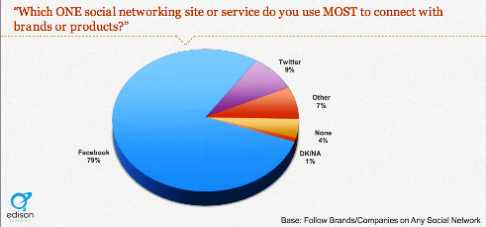 Are you wondering how consumers are using social media?
Are you wondering how consumers are using social media?
Would you like some insights to help your business better understand people's social habits?
In this article, I examine a report published by Edison Research focused on people's latest social habits.
These findings provide useful insights about consumer behavior and how your business can respond.
Here are 9 of the most interesting findings from the study.
#1: Almost 58 million Americans Use Social Sites Daily
A social habit is the tendency to use social media sites several times a day. By mid-2012, the number of Americans with the social habit had risen to 22% (approximately 58 million people) from 18% in 2011.

A similar study by NM Incite provides further insight as to why people use social media. 89% do it to keep in touch with friends and family, 67% for entertainment, 66% to learn about products and services and 48% for career networking.
Key Takeaway: As consumers invest more time on social media sites, try to find new ways to connect and engage with consumers throughout the day. For example, post a short question on your Facebook Page in the morning, a helpful article in the afternoon and an interesting photo or brief video in the evening. And don't forget weekends.
Remember too that consumers are interested in learning about your products and services, so showcase them and use appealing images and keyword-rich descriptions. Also consider introducing an e-commerce experience on your Facebook Page.
#2: Twitter Driving New and More Engaged Users
Twitter continued to draw new users by impressive numbers. 23% of consumers surveyed joined Twitter six months before, 30% joined less than a year before and another 25% joined less than two years before. The study also showed that engagement levels among Twitter users rose from 69% in 2011 to 76% in 2012.

Key Takeaway: New Twitter users will not know whom to follow right away. Make it easy for them to follow your business and tweet useful resources and thoughtful tips that answer their questions, rather than tweeting promotional content.
This will also help establish you as a thought leader in your industry, particularly if your tweets are focused mostly on a specific subject.
#3: 40% of Americans Exposed to “Tweets” from Traditional Media
The study found that 43% of Americans hear or read about “tweets” almost every day in traditional media. Another 16% hear this term regularly, but not daily. TV shows such as CNN's AC 360 and Piers Morgan Tonight are known for promoting and extending conversations to their Twitter platforms.
Get World-Class Marketing Training — All Year Long!
Are you facing doubt, uncertainty, or overwhelm? The Social Media Marketing Society can help.
Each month, you’ll receive training from trusted marketing experts, covering everything from AI to organic social marketing. When you join, you’ll also get immediate access to:
- A library of 100+ marketing trainings
- A community of like-minded marketers
- Monthly online community meetups
- Relevant news and trends updates

Key takeaway: Every day, TV audiences are being heavily exposed to Twitter and the idea of tweeting. If your business advertises on TV (or is thinking about it), be sure to encourage your audience to take the conversation online in the form of tweets. Don't forget to give viewers a unique hashtag to distinguish your brand.
To get your creative juices flowing, take a look at this stunning TV ad by American Express with numerous mentions of “tweets” and “Twitter.”
#4: Number of People Following Brands Doubles
This was an interesting discovery. Turns out that social media users are more interested in brands than ever before. In fact, brand-following behavior on social media sites increased by a respectable 17% in the last two years, and by 8% from 2011 to 2012. It's likely that this trend will continue on the same upward path.

Key Takeaway: According to Get Satisfaction, the top reasons why users follow brands are to get free offers and deals, because they are existing customers, for interesting or entertaining content and because their friends are fans of the brand. Make sure the offers you make on your website are also promoted on your social media channels. For example free research reports, webinars or product giveaways.
Be creative and change up your offers every so often to keep things fresh and your fans engaged.
#5: Facebook Dominates for Brands
A whopping 79% of consumers prefer to connect with brands on Facebook, while only 9% prefer Twitter for brand-following. Why Facebook?

Discover Proven Marketing Strategies and Tips
Want to go even deeper with your marketing? Check out the Social Media Marketing Podcast! Publishing weekly since 2012, the Social Media Marketing Podcast helps you navigate the constantly changing marketing jungle, with expert interviews from marketing pros.
But don’t let the name fool you. This show is about a lot more than just social media marketing. With over 600 episodes and millions of downloads each year, this show has been a trusted source for marketers for well over a decade.
- Facebook is a familiar space. Consumers already spend a lot of time there connecting with friends and family; therefore, it's a small effort on their part to connect with brands.
- Secondly, Facebook users are heavily influenced by their friends. If a friend likes a brand, they too will like a brand (remember “birds of a feather…”!).
- Finally, Facebook offers a more user-friendly and visually interesting interface than other platforms. This allows brands to leverage offers, giveaways, contests and other entertaining content in a more appealing way.

More consumers prefer to connect with brands on Facebook.
Key Takeaway: To increase the number of your Facebook fans, consider offering free gifts and entertaining content (or a combination of these). Otherwise you could also reward loyal fans and attract new ones by providing real value (i.e., 50% off or more—not 5% or 10%—according to Dave Kerpen of Likeable Media).
Again remember that contests and sweepstakes create a lot of excitement and energy, because the idea of shared opportunity spreads fast on Facebook.
#6: Young Facebook Users Have Lots of Friends
Notice from the graph that 18- to 24-year-old Facebook users have the highest number of friends, while more mature users have fewer friends. Keep in mind that “birds of a feather flock together,” so friends of fans tend to behave like actual fans on Facebook.

Key Takeaway: To increase your brand's visibility on Facebook, don't just target your fans, target their friends as well. Develop personas (or profiles) of your target audience and identify their demographics, interests, pain points, social behavior, etc.
This information will help you to create content that is highly optimized for them. Then create messages that are sharable, such as promotions that require voting (if a fan votes, their friends will be persuaded to vote as well). The idea is to get high visibility on your fans' newsfeeds, thus encouraging interaction with their friends as well.
#7: Only One-Quarter of Social Networkers Use “Daily Deals” Sites
Generally the American population is not crazy about daily deals services such as Groupon or LivingSocial, and only 23% of social networkers are registered users of these sites. Numerous sources suggest that there's a lot of buyer's remorse associated with Groupon.
But now Amazon and Google have grabbed a piece of the daily deals business. It'll be interesting to see how consumers respond to these brands over the next 12 months.

Key Takeaway: Unfortunately the entire Groupon business model has long been held in question. But from the consumer's point of view, everyone still likes a good deal. If you're using Groupon or Living Social, just be careful and make sure there is a profitable return for your business.
Otherwise you may want to reevaluate your goals to check whether this kind of model is still a good fit for you.
#8: One-Third of Social Media Users Do Not Interact
Most people like to engage (post status updates) on social media sites. However, 34% of users are silent for various reasons. According to TopRank Online Marketing Blog, some are lurkers (those who just sit tight and absorb information), while others are newbies who haven't quite honed their online social skills.

Key Takeaway: Silent users such as lurkers and newbies may not interact with friends or brands, but they are listening and can be valuable connections for your business. If you notice lurkers among your followers, try to reach out directly to them via direct messages. They'll be more likely to respond if you rouse them with a thought-provoking question or comment.
To draw out newbies, use the usual best practice of sharing tips, tricks and other helpful content. As they start to figure their way around, they'll remember you for helping them along the way.
#9: People Are Checking in Less Frequently
Both Gowalla and Foursquare saw sharp declines in user activity in 2012. In fact, 57% of users said they “almost never” check in. Of course, Gowalla shut down in early 2012, but even with Foursquare still open for business, consumers started to opt out of the check-in craze due to privacy concerns, according to a study published on Mashable. Others did not consider badges or upgraded status to be sufficient motivation to check in.

Key Takeaway: If you use location-based marketing to promote your business, try using a combination of specials and discounts to encourage more clients. Because people are concerned about privacy and safety issues, your business will have to offer unrivaled deals for customers to give up their location. For example, “Check in with three friends and get four free drinks,” or “Mayor gets 35% off entire bill.”
Final Wrap-up
Marketers have a great opportunity to respond to these findings and develop strategies that appeal to changing consumer habits. Continue to focus on Facebook and Twitter as these platforms draw in new users. On the downside, be careful about using daily deals and location-based marketing because consumers are apprehensive about these services.
Over to you: What do you think? As a marketer, which of these social habits did you find most interesting? Please tell us why you think so and share your thoughts below.
Attention Agency Owners, Brand Marketers, and Consultants

Introducing the Marketing Agency Show–our newest podcast designed to explore the struggles of agency marketers.
Join show host and agency owner, Brooke Sellas, as she interviews agency marketers and digs deep into their biggest challenges. Explore topics like navigating rough economic times, leveraging AI, service diversification, client acquisition, and much more.
Just pull up your favorite podcast app, search for Marketing Agency Show and start listening. Or click the button below for more information.

